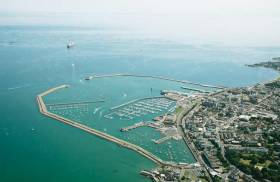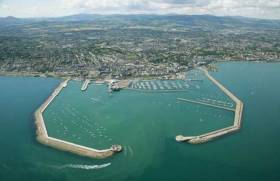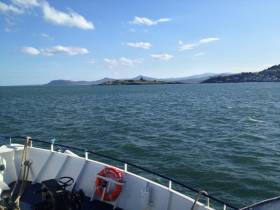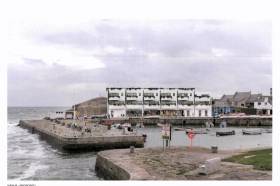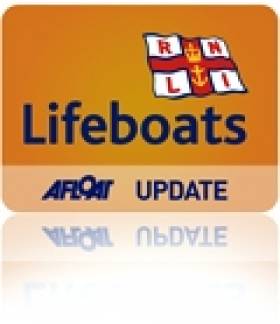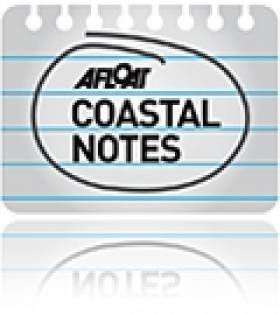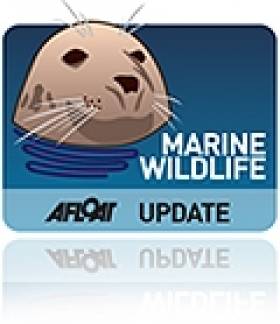Displaying items by tag: dlrcoco
Is Dun Laoghaire Harbour Finally In County Council Hands?
#DLHarbour - Has Dun Laoghaire Harbour finally been transferred to the local county council?
That appears to be the case, according to a tweet yesterday evening (Monday 9 April) from Green Party Councillor Ossian Smyth.
The tweet quotes Transport Minister Shane Ross, who has sole discretion on the matter, as determining that “responsibility for the future of the port lies with DLR County Council”.
Shane Ross (as Transport Minister) has agreed to dissolve Dún Laoghaire Harbour Company on foot of a request from the council. The council will take over the running of the Harbour. pic.twitter.com/4SITCaZyDd
— Cllr Ossian Smyth (@smytho) April 9, 2018
Dun Laoghaire-Rathdown County Council was understood to be meeting yesterday following its earlier vote to recommend the dissolution of Dun Laoghaire Harbour Company and transfer its assets to the local authority.
Afloat.ie will have more on this story as it develops.
See also: Could Council Vote Signal a New Master Plan for Dun Laoghaire Harbour?
DLRCoCo To Recommend Dissolution Of Dun Laoghaire Harbour Company For Council Control
#DLHarbour - Dun Laoghaire-Rathdown County Council will recommend the dissolution of Dun Laoghaire Harbour Company and the transfer of its assets to the local authority at a meeting next week, The Irish Times reports.
Following months of slow progress, DLRCoCo chief executive Philomela Poole will tell councillors on Tuesday 6 March that the second of two options as outlined in the Harbours Act 2015 is best to help secure Dun Laoghaire’s future — a move that is being hailed by local campaigners Save Our Seafront.
In an information pack distributed to DLRCoCo members in advance of next week’s meeting, as seen by Afloat.ie, Poole states: “It has become increasingly clear over the past decade that the long-term future of Dun Laoghaire Harbour Company will be in terms of marine leisure, maritime tourism, cultural amenity and urban redevelopment … Therefore it is appropriate that the plans be developed under the aegis of and in co-operation with Dún Laoghaire-Rathdown County Council.”
Under the Harbours Act 2015, the Minister for Transport may choose between two options for the future governance of Dun Laoghaire Harbour: the transfer of shareholding of the harbour company to DLRCoCo, or the dissolution of the company and transfers of its assets, liabilities and staff to the local authority.
A risk assessment undertaken by consultants The Finance Expert concluded that the financial risks to the council “would be common to both options” but of the two, the second gives “a lower operational risk and more direct control of the harbour’s activities.”
The risk assessment, based on accounts ending 31 December 2016, projects the net financial risk for the period 2018-2022 as €33.5 million — the bulk of this to bring the harbour up to ‘taking-in-charge’ standard.
However, Afloat.ie understands that a figure in excess of €150 million over 10 years for harbour infrastructure alone has been mooted — while another source estimates conservation and repair at some €250,000 per annum.
In addition, the risk assessment did not examine or evaluate “potential legal costs associated with resolving the ownership of the foreshore at St Michael’s Pier.”
The Irish Times has more on the story HERE.
See also: David O’Brien on Dun Laoghaire’s need for a ‘harbour czar’ to steer it on the right course.
Dun Laoghaire Harbour Company 'Risk' Report to be Presented to DLRCoCo Next Month (UPDATED).
Minister Transport Minister for Transport, Tourism and Sport, Shane Ross TD expects the final report of the risk assessor on the hand over of Dun Laoghaire Harbour Company to the local County Council will be presented to the council at a meeting scheduled to take place on 26 February but now changed to Tuesday, March 6th.
UPDATE: A DLRCoCo spokesperson advises meeting will now be held on March 6th at 6.30pm and will be webcast.
Minister Ross says that after that he 'expects matters to then progress towards the agreement of a model and a transfer date'.
The information was given to Senator Victor Boyhan who called on the Minister to 'indicate his intentions to authorise the transfer of Dún Laoghaire Harbour Company from the State to Dún Laoghaire-Rathdown County Council', as provided for under the Harbours Act 2015.
In a detailed reply to the Senator, Ross also told the Seanad, 'there are two court cases which constrains me enormously in terms of what I can say about some of the issues raised'.
'They are very delicate issues and I do not want to say anything which would prejudice the case', he added.
Read the details from the Seanad Éireann debate Tuesday, 6 Feb 2018 here.
Boyhan previously raised the matter of the transfer of the Harbour to the County Council in December, as Afloat.ie reported here
#BiosphereTours – Dublin Bay Biosphere Guided Tours begin today from Dun Laoghaire Harbour, Dublin and Howth and on every Wednesday until 14 June, writes Jehan Ashmore.
Dublin Bay which is internationally recognised for its wealth of marine wildlife and cultural heritage was in 2015 awarded a “UNESCO Biosphere”. The designation status from United Nations Educational, Scientific and Cultural Organisation was in recognition to unique places such as Dublin Bay. The biosphere is actively managed to promote a balanced relationship between people and nature. To find out much more, to get involved and events click here.
Dun Laoghaire-Rathdown County Council as part of the Dublin Bay Biosphere Partnership, encourage you to take this opportunity in appreciating our beautiful bay from a truly unique perspective.
In addition to marine wildlife (including ceteceans) there are stunning landscapes views of the Dublin Mountains and to the south in the bay is Dalkey Island. While off Howth Peninula with its cliffs, lies Ireland’s Eye and further offshore Lambay Island. In the far distance are also the Mountains of Mourne.
Manmade landmarks can also be observed, among them Joyce’s Martello Tower, Sandycove, the Poolbeg Lighthouse that marks the entrance to Dublin Port and the capital. On the bay's north side approaches to the port is another iconic coastal landmark the Baily Lighthouse.
Operating the Biosphere Tours in conjunction with Dublin Bay Cruises is the excursion vessel, St Bridget. The (pre-booked) tours up to Wednesday 14 June will run between 60-90 minutes duration depending on which route is taken.
Embarkation locations: Dun Laoghaire Harbour (East Pier), Dublin on the Liffey (Sir John Rogerson’s Quay) and in Howth Harbour (West Pier).
For more information on tours and cruise routes, times, charges and booking information, click here.
#BullochPublic - In a move being considered by Dun Laoghaire-Rathdown County Council, the local authority could bring land at Bulloch Harbour in Dalkey into public ownership.
The decision reports DublinLive, would also see the land developed in the public’s interest, was made at this month’s full meeting of the council.
A masterplan for the area cannot be considered by any planning authority unless it is submitted by the owners of the land being considered for development.
As a result, councillors have called on the council to consider taking ownership of the land.
DLRCoCo Staff Donate HUG Funds to RNLI Dun Laoghaire
#rnli – The Staff of Dun Laoghaire Rathdown County Council (DLRCC) selected Dun Laoghaire RNLI lifeboat as the beneficiary of the 2014 Hope You Give (HUG) charity fund paid into over the year by the staff of DLRCC.
Above, Mary Kennefick, representing HUG (pictured left), presented the donation to Mark McGibney, RNLI Coxswain with Rita O'Reilly, Honorary Secretary of the RNLI Dun Laoghaire fundraising branch and Barry Keane, Vice Chairman.
#dlrcc – Dún Laoghaire-Rathdown County Council (DLRCoCo) has tweeted an artist's impression of Dún Laoghaire Baths complete with a new walkway connecting Sandycove to the East Pier and a refurbished Dun Laoghaire Baths building.
DLRCoCo has applied to the Minister of the Environment, Community and Local Government for consent under the Foreshore Act, 1933, to undertake refurbishment of Dún Laoghaire Baths and 'associated works'.
A copy of the application, and the relevant maps, plans and drawings, are available for inspection for the next 21 working days, free of charge, at Dún Laoghaire Garda Station, 34/35 Corrig Avenue, Dún Laoghaire, Co Dublin.
Birdwatch Ireland: Dalkey Island Evening Viewings
#MARINE WILDLIFE – The South Dublin Branch of BirdWatch Ireland is organising outdoor meetings over the summer which include watching terns and other species during July at Coliemore Harbour, Dalkey, writes Jehan Ashmore.
The first meeting is Tuesday 3rd July (6.30-8pm) and every other Tuesday during the month. None-members of Birdwatch Ireland are invited to the evenings which are run in conjunction with Dun Laoghaire-Rathdown County Council (DLRCoCo).
During the seabird viewing evenings, BirdWatch Ireland experts will be on hand to show the breeding terns and other birds whose habitat is not just confined to Dalkey Island. The island encompasses Lamb Island and the rocky outcrops of Clare and Maiden Rocks which straddle towards Dublin Bay while to the east of the island lies The Muglins with its lighthouse.
For further information including the Dalkey Tern Project visit: www.southdublinbirds.com/events/events.php and www.dlrevents.ie/
#DALKEY ISLAND PROSPECT- At a public meeting held by Dalkey Community Council last night, it was almost unanimously agreed that a public enquiry should be held over the foreshore licence sought by Providence Resources to carry out exploratory drilling for oil and gas, in the Kish Bank basin, some 6kms off Dalkey Island, writes Jehan Ashmore.
Over 200 residents attended the meeting in Dalkey Town Hall where they heard Tanaiste Eamon Gilmore and Dun Laoghaire-Rathdown County Councillors deal with the issues raised over the proposed seismic survey and exploratory well drill. Among the major issues was the project's proximity to the populated coastline and its special areas of conservation. It was pointed out that Norwegian drilling operations took place at least 25km offshore.
Mr. Gilmore said the fisheries conservation order in which he was engaged with during his role as Minister of State for Marine would form part of his personal submission to the Department of the Environment. When questioned from the floor if he would make his submission public, he said that for transparency he would do so "reflecting concerns of his constituents".
Providence Resources were invited to attend the meeting, but they declined on grounds of the size of the meeting, though small groups can discuss the exploratory drilling of the 'Dalkey Island' prospect at their Donnybrook headquarters.
The company have said that the work they want to do is purely exploratory and relatively low-key and that it can be undertaken unnoticed, with no adverse environmental effects.
Tom Kivlehan of the Green Party, who had last week called on Minister of the Environment Phil Hogan to establish a public enquiry, said: "There are huge concerns among the people of Dublin about the proposed application and they feel that the process does not afford them the opportunity to have their questions and worries answered."
Mr Kivlehan emphasised, however, that the risks and benefits must be balanced. This point was also made by former Green Party T.D. Ciaran Cuffe who said that while untold damage could be done, "we must evaluate everything very carefully."
People Before Profit T.D. Richard Boyd Barrett said he was "absolutely opposed" to the proposal and the impact it would have on Dublin Bay as an amenity and to tourism. He called at the very least for a public enquiry to be carried out before a decision on granting the licence is made and claimed that there were no guarantees that any oil would be discovered or the potential financial benefits of a find would go to the Irish people.
- Dublin Bay
- dlrcoco
- Green Party
- Dalkey Island
- Providence Resources
- Kish Bank Basin
- Dalkey Island Prospect
- Dun LaoghaireRathdown County Council
- Coastal Notes
- Dalkey Community Council
- Foreshore License
- Department of Environment
- Tanaiste Eamon Gilmore
- Dalkey Town Hall
- Exploratory Drilling
- Public Enquiry
- Minister Hogan
'Seafront Memorials' Tours of Dun Laoghaire Harbour
The tour which is free starts at the meeting point of the Queen Victoria Fountain which too forms part of the tour alongside the George VI memorial
and the Christ the King monument.
The outdoor event is part of the 'Summer of Heritage' which is organised by Dun Laoghaire-Rathdown County Council. The initiative is now in its fourth year and this year's highlight of the programme are tours of the newly renovated Seapoint Martello tower.
The coastal structure has been restored and is a fine example of these 19th century defensive forts, built along the coast to defend during the Napoleonic wars.
This summer also sees Carrickbrennan graveyard feature for the first time, the resting place of many sailors lost in maritime disasters since the 17th century.
Sightseeing along 'The Metals', a historic pathway that linked the quarry in Dalkey to the harbour in Dún Laoghaire also returns in the programme due to its popularity last year.
To read more about the the Summer of Heritage other free events in the arts, literature, sports, music and for the family, go to www.dunlaoghaire.ie/summer-of-heritage/ and www.dlrevents.ie/heritage11.html
- Events
- RNLI
- dlrcoco
- Dublin Bay News
- Dun Laoghaire Harbour
- Coastal Notes
- Dun Laoghaire News
- Seafront Memorials
- Guided Tours
- DunLaoghaireRathdown County Council
- DLR
- DLR events
- Martello Towers
- Seapoint Martello Tower
- The 'Metals'
- Queen Victoria Fountain
- King George VI monument
- Crimean War cannon
- Event news
- Napoleon
- Napoleonic Wars
- 1895 Dun Laoghaire Lifeboat Disaster
- RNLI Dun Laoghaire
- Christ the King monument
- Summer of Heritage


























